brake light PORSCHE CAYNNE 2010 1.G Information Manual
[x] Cancel search | Manufacturer: PORSCHE, Model Year: 2010, Model line: CAYENNE, Model: PORSCHE CAYENNE 2010 1.GPages: 68, PDF Size: 4.52 MB
Page 6 of 68
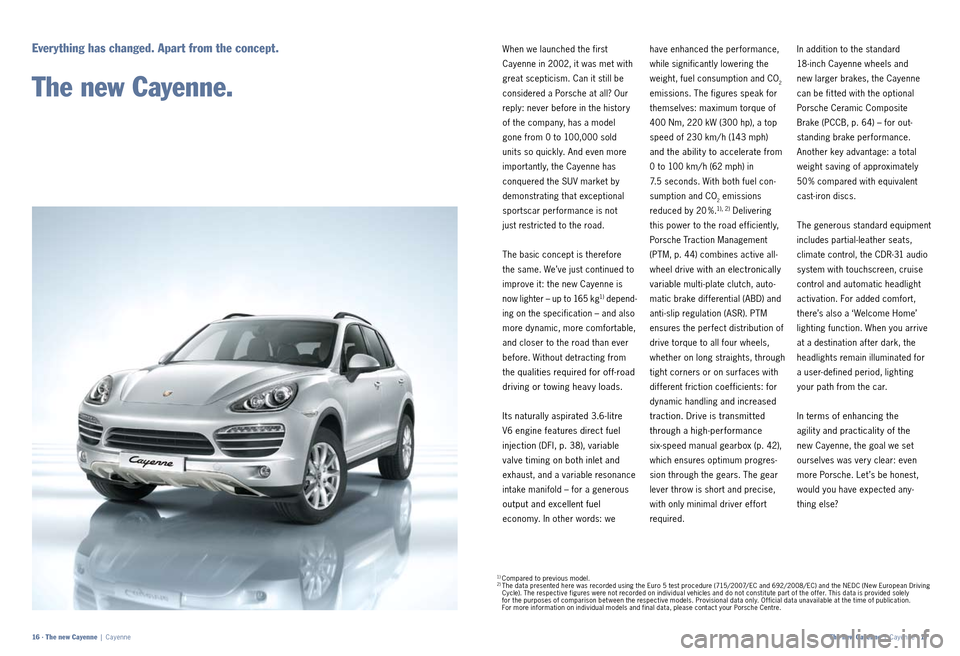
When we launched the first
Cayenne in 2002, it was met with
great scepticism. Can it still be
considered a Porsche at all? Our
reply: never before in the history
of the company, has a model
gone from 0 to 100,000 sold
units so quickly. And even more
importantly, the Cayenne has
conquered the SUV market by
demonstrating that exceptional
sportscar performance is not
just restricted to the road.
The basic concept is therefore
the same. We’ve just continued to
improve it: the new Cayenne is
now lighter – up to 165 kg1) depend
ing
on the specification – and also
more dynamic, more comfortable,
and closer to the road than ever
before. Without detracting from
the
qualities required for off road
driving or towing heav y loads.
Its naturally aspirated 3.6 litre
V6 engine features direct fuel
injection (DFI, p. 38), variable
valve timing on both inlet and
exhaust, and a variable resonance
intake manifold – for a generous
output and excellent fuel
economy. In other words: we have enhanced the performance,
while significantly lowering the
weight, fuel consumption and CO
2
emissions. The figures speak for
themselves: maximum torque of
400 Nm, 220 kW (300 hp), a top
speed of 230 km/ h (143 mph)
and the abilit y to accelerate from
0 to 100 km/ h (62 mph) in
7.5 se conds. With both fuel con
sumption and CO
2 emissions
reduced by 20 %.
1), 2) Delivering
this power to the road efficiently,
Porsche Traction Management
(PTM, p. 44) combines active all
wheel drive
with an electron ically
variable
multi plate clutch, auto
matic brake dif ferential (ABD) and
anti slip regulation (ASR). PTM
ensures the perfect distribution of
drive torque to all four wheels,
whether on long straights, through
tight corners or on surfaces with
dif ferent friction coef ficients: for
dynamic handling
and increased
traction. Drive is transmit ted
through a high performance
six speed manual gearbox (p. 42),
which ensures optimum progres
sion through the gears. The gear
lever throw is short and precise,
with only minimal driver ef fort
required. In addition to the standard
18
inch Cayenne wheels and
new larger brakes, the Cayenne
can be fit ted with the optional
Porsche Ceramic Composite
Brake (PCCB, p. 64) – for out
standing brake performance.
Another key advantage: a total
weight saving of approximately
50 % compared with equivalent
cast iron discs.
The generous standard equipment
includes partial leather seats,
climate control, the CDR 31 audio
system with touchscreen, cruise
control and automatic headlight
activation. For added comfort,
there’s also a ‘Welcome Home’
lighting function. When you arrive
at a destination af ter dark, the
headlights remain illuminated for
a user defined period, lighting
your path from the car.
In terms of enhancing the
agility
and practicalit y of the
new
Cayenne, the goal we set
ourselves was very clear: even
more Porsche. Let ’s be honest,
would you have expected any
thing else?
Everything has changed. Apart from the concept.
The new Cayenne.
1) Compared to previous model.2) The data presented here was recorded using the Euro 5 test procedure (715/2007/ EC and 692/2008/ EC) and the NEDC (New European Driving
Cycle). The respective figures were not recorded on individual vehicles and do not constitute part of the of fer. This data is provided solely
for the purposes of comparison bet ween the respective models. Provisional data only. Of ficial data unavailable at the time of publication.
For more information on individual models and final data, please contact your Porsche Centre.
The new Cayenne | Cayenne · 17
16 · The new Cayenne | Cayenne
Page 16 of 68

Standard on the new Cayenne
Diesel, new Cayenne S, new
Cayenne S Hybrid and new
Cayenne Turbo. Available as an
option for the new Cayenne
in conjunction with the optional
Tiptronic S.
VarioCam Plus.
VarioCam Plus creates t wo en
gines out of one by steplessly
adjusting the inlet valve timing
and lift.
The system dif ferentiates
bet ween normal road usage and
performance driving, adapting
seamlessly as driver inputs
change. All functions are auto
matically controlled by the
engine management system.
All you experience is responsive
acceleration and ultra smooth
running characteristics. Inlet valve
timing is steplessly adjusted. To
improve response when starting
from cold, for example, VarioCam
Plus selects the higher lif t set ting
and retards valve timing.
At medium revs and minimal
load, the valve lif t is lowered and
timing advanced to minimise fuel
consumption and emissions. At
low engine speeds in particular,
VarioCam Plus significantly im
proves fuel economy. To achieve maximum power and torque, the
valve lif t is raised and the timing
advanced.
Overall, the system provides
greater performance with rela
tively modest fuel consumption.
Standard on the new Cayenne S
and new Cayenne Turbo.
Variable valve timing.
The V6 engine in the Cayenne
features variable valve timing
on both inlet and exhaust. The camshaft phase angles
are continuously varied by
the engine management system
via rotary vane adjusters.
On the new Cayenne S Hybrid, the
inlet valve timing is continuously
adjusted.
The key benefits include bet ter
fuel economy and lower emis
sions. It also helps to generate
greater power and torque –
even at low engine speeds.
Standard on the new Cayenne
and new Cayenne S Hybrid.
The starter motor has been re
vised to cope with the additional
demands of the system, and
the bat tery charge and life are
continuously monitored. The
bat tery and starter motor are
replacement parts that are
subject to greater wear and
tear with frequent use of the
auto start /stop function.
systems remain switched on and
the standard climate control
continues to maintain the selected
temperature. The only changes
you’ll perceive: peace and quiet
and – thanks to greater fuel
economy – also peace of mind.
The system is deactivated in
certain situations, e.g. if the
outside temperature is very
high or the bat tery charge is low.
Auto start/stop function.
The new Cayenne models that
are equipped with the new eight
speed Tiptronic S also feature an
auto start /stop function. If, for
example, you stop at traf fic lights
with your foot on the brake pedal,
the auto start /stop function will
automatically cut the engine.
Although the engine is not running,
all audio and communication
The heart of every Porsche.
Applying power with intelligence.
Engine technology.
VarioCam Plus
Drive systems and chassis | Engine technology · 37
Page 28 of 68
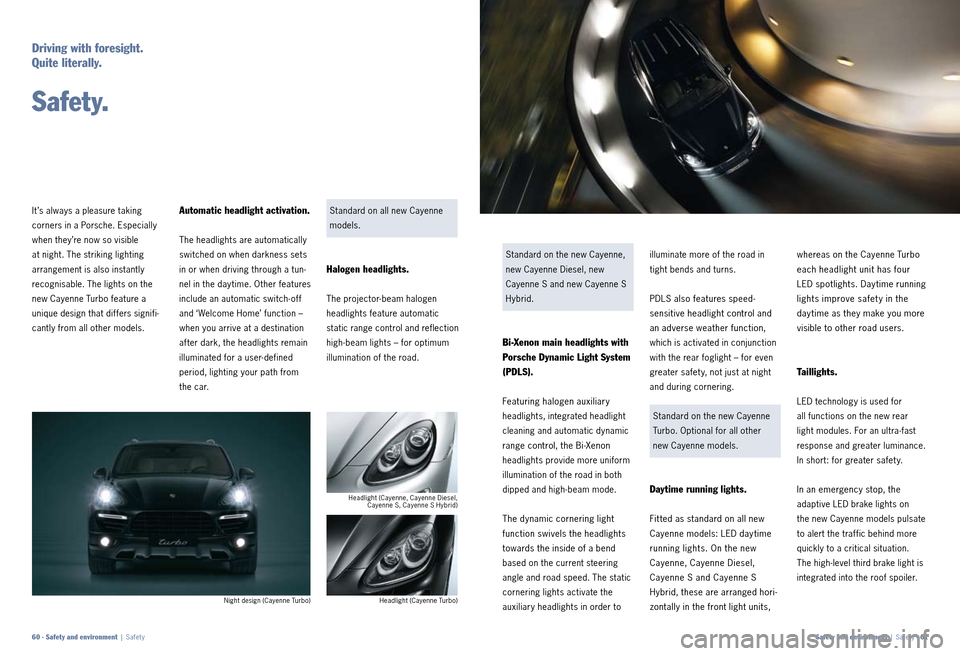
Standard on all new Cayenne
models.
Halogen headlights.
The projectorbeam halogen
headlights feature automatic
static range control and reflection
high beam lights – for optimum
illumination of the road.
Standard on the new Cayenne,
new Cayenne Diesel, new
Cayenne S and new Cayenne S
Hybrid.
Bi-Xenon main headlights with
Porsche Dynamic Light System
(PDLS).
Featuring halogen auxiliary
headlights, integrated headlight
cleaning and automatic dynamic
range control, the Bi Xenon
headlights provide more uniform
illumination of the road in both
dipped and high beam mode.
The dynamic cornering light
function swivels the headlights
towards the inside of a bend
based on the current steering
angle and road speed. The static
cornering lights activate the
auxiliary headlights in order to illuminate more of the road in
tight bends and turns.
PDLS also features speed
sensitive headlight control and
an adverse weather function,
which is activated in conjunction
with the rear foglight – for even
greater safet y, not just at night
and during cornering.
Standard on the new Cayenne
Turbo. Optional for all other
new Cayenne models.
Daytime running lights.
Fit ted as standard on all new
Cayenne models: LED day time
running lights. On the new
Cayenne, Cayenne Diesel,
Cayenne S and Cayenne S
Hybrid, these are arranged hori
zontally in the front light units, whereas on the Cayenne Turbo
each headlight unit has four
LED spotlights. Day time running
lights improve safet y in the
day time as they make you more
visible to other road users.
Taillights.
LED technology is used for
all functions on the new rear
light modules. For an ultra fast
response and greater luminance.
In short: for greater safet y.
In an emergency stop, the
adaptive LED brake lights on
the new Cayenne models pulsate
to alert the traf fic behind more
quickly to a critical situation.
The high level third brake light is
integrated into the roof spoiler.
Automatic headlight activation.
The headlights are automatically
switched on when darkness sets
in or when driving through a tun
nel in the day time. Other features
include an automatic switch of f
and ‘Welcome Home’ function –
when you arrive at a destination
after dark, the headlights remain
illuminated for a user defined
period, lighting your path from
the car.
It ’s always a pleasure taking
corners in a Porsche. Especially
when they’re now so visible
at night. The striking lighting
arrangement is also instantly
recog
nisable. The lights on the
new Cayenne Turbo feature a
unique design that differs signifi
cantly from all other models.
Driving with foresight.
Quite literally.
S a f e t y.
Night design (Cayenne Turbo) Headlight (Cayenne, Cayenne Diesel,
Cayenne S, Cayenne S Hybrid)
Headlight (Cayenne Turbo)
Safety and environment | Safet y · 61
60 · Safety and environment | Safet y
Page 29 of 68

All Cayenne models have internal
ly vented discs all round, ensuring
consistent performance during
heav y use. The front disc dimen
sions (diameter/thickness) are
350 mm/34 mm on the new
Cayenne and new Cayenne Diesel,
360 mm/36 mm on the new
Cayenne S and new Cayenne S
Hybrid, and 390 mm/38 mm on
the new Cayenne Turbo. All models have six
piston
monobloc aluminium brake
calipers at the front and four
piston equivalents at the rear.
The calipers are black on the new
Cayenne and new Cayenne Diesel
and silver on the new Cayenne S
and new Cayenne S Hybrid. On
the new Cayenne Turbo, they
feature a striking red paint finish. Braking is assisted by a tandem
booster and large brake master
cylinder. Further assistance is
provided by PSM (p. 66).
The pads are equipped with
individual wear sensors. When
new pads are required, a
warning light is illuminated in
the instrument cluster.
Electric parking brake.
Manually activated and deactivat
ed, the electric parking brake
releases automatically as you drive
off.
Automatic hold function.
With the automatic hold function,
you can pull away on the flat or a
slope without ever rolling back.
The system automatically detects
when the vehicle has come to a
halt on an uphill gradient. PSM then
maintains the brake pressure at all
four wheels for a brief period to
prevent the vehicle from moving in
the opposite direction.
Braking systems.
Porsche brakes are renowned
worldwide as the benchmark in
performance
and durabilit y.
Equipped with new braking
systems, the new Cayenne
models continue this tradition.
The larger brakes of fer excellent
deceleration – even when the
car is fully laden with five adult
occupants, a full complement
of luggage and a braked trailer
load of up to 3,500 kg (Cayenne
with manual gearbox: 2,700 kg).
Outstanding brake performance.
To the point.
Standard braking system
(Cayenne/Cayenne Diesel) Standard braking system
(Cayenne S/Cayenne S Hybrid) Standard braking system (Cayenne Turbo)
Safety and environment
| Safet y · 63
62 · Safety and environment | Safet y
Page 30 of 68
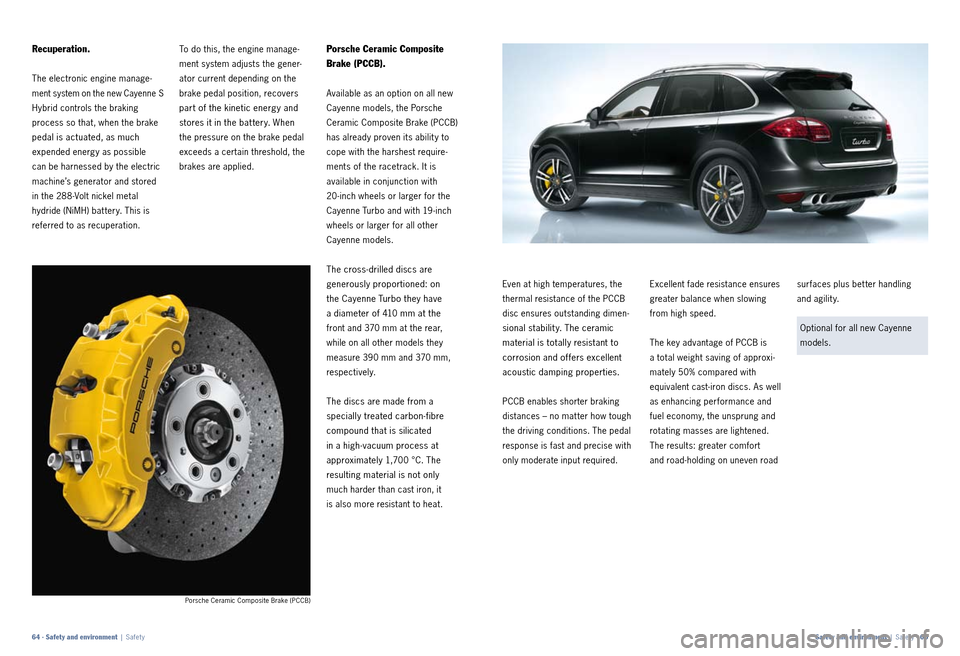
Porsche Ceramic Composite Brake (PCCB)
To do this, the engine manage
ment system adjusts the gener
ator current depending on the
brake pedal position, recovers
part of the kinetic energy and
stores it in the bat tery. When
the pressure on the brake pedal
exceeds a certain threshold, the
brakes are applied.
Porsche Ceramic Composite
Brake (PCCB).
Available as an option on all new
Cayenne models, the Porsche
Ceramic Composite Brake (PCCB)
has already proven its abilit y to
cope with the harshest require
ments of the racetrack. It is
available in conjunction with
20 inch wheels or larger for the
Cayenne Turbo and with 19 inch
wheels or larger for all other
Cayenne models.
The cross drilled discs are
generously proportioned: on
the Cayenne Turbo they have
a diameter of 410 mm at the
front and 370 mm at the rear,
while on all other models they
measure 390 mm and 370 mm,
respectively.
The discs are made from a
specially treated carbon fibre
compound that is silicated
in a high vacuum process at
approximately 1,700 °C. The
resulting material is not only
much harder than cast iron, it
is also more resistant to heat. Even at high temperatures, the
thermal resistance of the PCCB
disc ensures outstanding dimen
sional stabilit y. The ceramic
material is totally resistant to
corrosion and offers excellent
acoustic damping properties.
PCCB enables shorter braking
distances – no mat ter how tough
the driving conditions. The pedal
response is fast and precise with
only moderate input required. Excellent fade resistance ensures
greater balance when slowing
from high speed.
The key advantage of PCCB is
a total weight saving of approxi
mately 50% compared with
equivalent cast iron discs. As well
as enhancing performance and
fuel economy, the unsprung and
rotating masses are lightened.
The results: greater comfort
and road holding on uneven road surfaces plus bet ter handling
and agility.
Optional for all new Cayenne
models.
Recuperation.
The electronic engine manage
ment system on the new Cayenne S
Hybrid controls the braking
process so that, when the brake
pedal is actuated, as much
expended energy as possible
can be harnessed by the electric
machine’s generator and stored
in the 288 Volt nickel metal
hydride (NiMH) bat tery. This is
referred to as recuperation.
Safety and environment | Safet y · 65
64 · Safety and environment | Safet y
Page 31 of 68
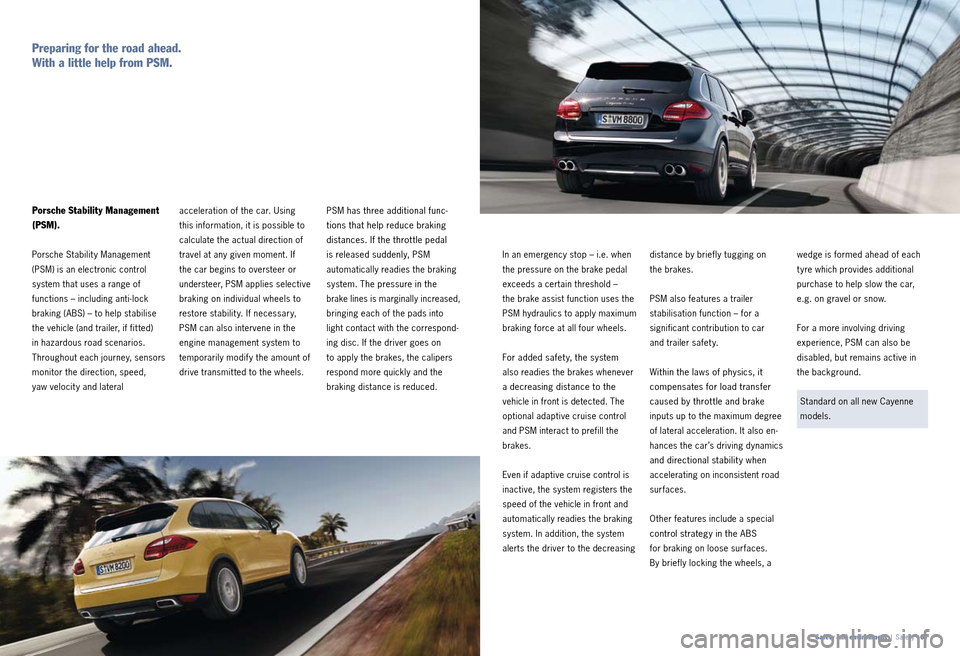
PSM has three additional func
tions that help reduce braking
distances. If the throt tle pedal
is released suddenly, PSM
automatically readies the braking
system. The pressure in the
brake lines is marginally increased,
bringing each of the pads into
light contact with the correspond
ing disc. If the driver goes on
to apply the brakes, the calipers
respond more quickly and the
braking distance is reduced. In an emergency stop – i.e. when
the pressure on the brake pedal
exceeds a certain threshold –
the brake assist function uses the
PSM hydraulics to apply maximum
braking force at all four wheels.
For added safet y, the system
also readies the brakes whenever
a decreasing distance to the
vehicle in front is detected. The
optional adaptive cruise control
and PSM interact to prefill the
brakes.
Even if adaptive cruise control is
inactive, the system registers the
speed of the vehicle in front and
automatically readies the braking
system. In addition, the system
alerts the driver to the decreasing distance by briefly tugging on
the brakes.
PSM also features a trailer
stabilisation function – for a
significant contribution to car
and trailer safet y.
Within the laws of physics, it
compensates for load transfer
caused by throt tle and brake
inputs up to the maximum degree
of lateral acceleration. It also en
hances the car’s driving dynamics
and directional stabilit y when
accelerating on inconsistent road
surfaces.
Other features include a special
control strategy in the ABS
for braking on loose surfaces.
By briefly locking the wheels, a wedge is formed ahead of each
t yre which provides additional
purchase to help slow the car,
e.g. on gravel or snow.
For a more involving driving
experience, PSM can also be
disabled, but remains active in
the background.
Standard on all new Cayenne
models.
accele
ration of the car. Using
this information, it is possible to
calculate the actual direction of
travel at any given moment. If
the car begins to oversteer or
understeer, PSM applies selective
braking on individual wheels to
restore stabilit y. If necessar y,
PSM can also intervene in the
engine management system to
temporarily modif y the amount of
drive transmit ted to the wheels.
Porsche Stability Management
(PSM).
Porsche Stabilit y Management
(PSM) is an electronic control
system that uses a range of
functions – including anti lock
braking (ABS) – to help stabilise
the vehicle (and trailer, if fit ted)
in hazardous road scenarios.
Throughout each journey, sensors
monitor the direction, speed,
yaw velocit y and lateral
Preparing for the road ahead.
With a little help from PSM.
Safety and environment | Safet y · 67
Page 66 of 68
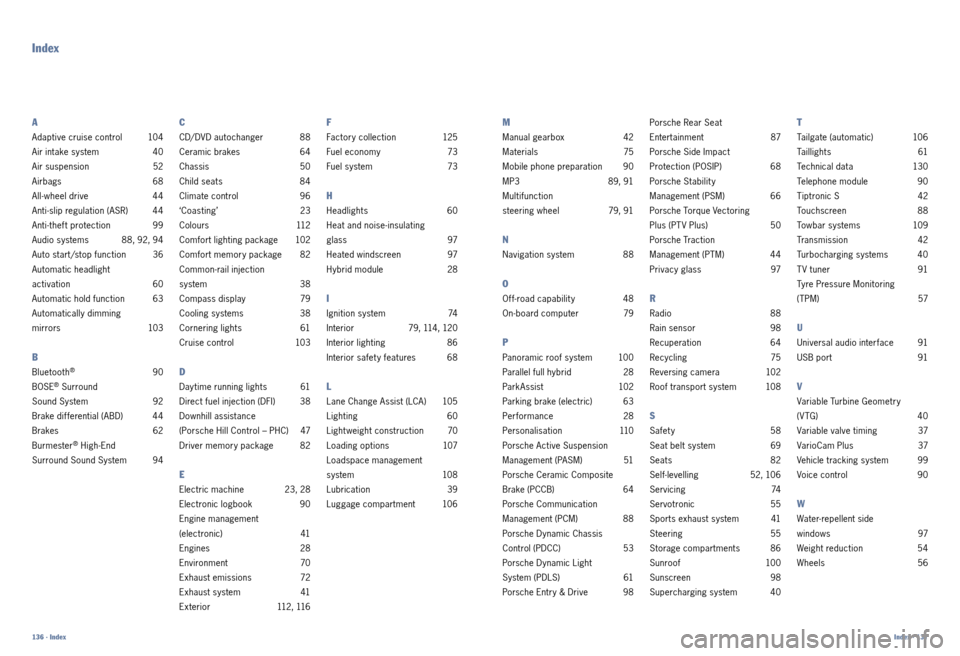
Index
A
Adaptive cruise control 104
Air intake system 40
Air suspension 52
Airbags 68
All wheel drive 44
Anti slip regulation (ASR) 44
Anti theft protection 99
Audio systems 88, 92, 94
Auto start /stop function 36
Automatic headlight
activation 60
Automatic hold function 63
Automatically dimming
mirrors 103
B
Bluetooth® 90
BOSE
® Surround
Sound System 92
Brake differential (ABD) 44
Brakes 62
Burmester
® High End
Surround Sound System 94
C
CD/ DVD autochanger 88
Ceramic brakes 64
Chassis 50
Child seats 84
Climate control 96
‘Coasting’ 23
C o l o u r s 112
Comfort lighting package 102
Comfort memory package 82
Common rail injection
system 38
Compass display 79
Cooling systems 38
Cornering lights 61
Cruise control 103
D
Day time running lights 61
Direct fuel injection (DFI) 38
Downhill assistance
(Porsche Hill Control – PHC) 47
Driver memory package 82
E
Electric machine 23, 28
Electronic logbook 90
Engine management
(electronic) 41
Engines 28
Environment 70
Exhaust emissions 72
Exhaust system 41
E x t e r i o r 112 , 116
F
Factory collection 125
Fuel economy 73
Fuel system 73
H
Headlights 60
Heat and noise insulating
glass 97
Heated windscreen 97
Hybrid module 28
I
Ignition system 74
Interior 79, 114, 120
Interior lighting 86
Interior safet y features 68
L
Lane Change Assist (LCA) 105
Lighting 60
Lightweight construction 70
Loading options 107
Loadspace management
system 108
Lubrication 39
Luggage compartment 106
M
Manual gearbox 42
Materials 75
Mobile phone preparation 90
MP3 89, 91
Multifunction
steering wheel 79, 91
N
Navigation system 88
O
Offroad capabilit y 48
On board computer 79
P
Panoramic roof system 100
Parallel full hybrid 28
Park Assist 102
Parking brake (electric) 63
Performance 28
Personalisation 110
Porsche Active Suspension
Management (PASM) 51
Porsche Ceramic Composite
Brake (PCCB) 64
Porsche Communication
Management (PCM) 88
Porsche Dynamic Chassis
Control (PDCC) 53
Porsche Dynamic Light
System (PDLS) 61
Porsche Entry & Drive 98Porsche Rear Seat
Entertainment 87
Porsche Side Impact
Protection (POSIP) 68
Porsche Stabilit y
Management (PSM) 66
Porsche Torque Vectoring
Plus (PT V Plus) 50
Porsche Traction
Management (PTM) 44
Privacy glass 97
R
Radio 88
Rain sensor 98
Recuperation 64
Recycling 75
Reversing camera
1
02
Roof transport system 108
S
Safety 58
Seat belt system 69
Seats 82
Self levelling 52, 106
S e rv i c i n g 74
Servotronic 55
Sports exhaust system 41
Steering 55
Storage compartments 86
S u n r o o f 10 0
Sunscreen 98
Supercharging system 40
T
Tailgate (automatic) 106
Taillights 61
Technical data 130
Telephone module 90
Tiptronic S 42
Touchscreen 88
Towbar systems 109
Tra n s m i s si o n 42
Turbocharging systems 40
T V tuner 91
Tyre Pressure Monitoring
( T PM) 57
U
Universal audio interface 91
USB port 91
V
Variable Turbine Geometry
(V TG) 40
Variable valve timing 37
VarioCam Plus 37
Vehicle tracking system 99
Voice control 90
W
Waterrepellent side
windows 97
Weight reduction 54
Wheels 56
Index · 137
136 · Index